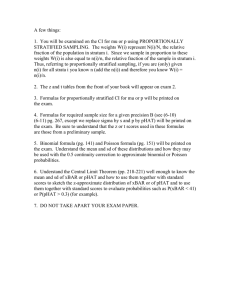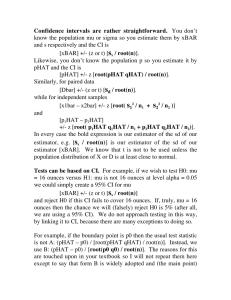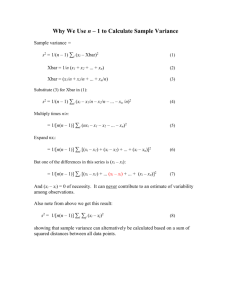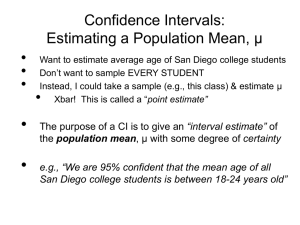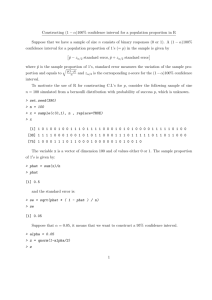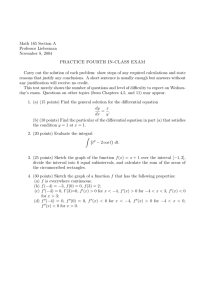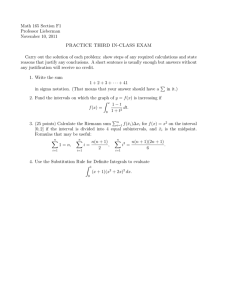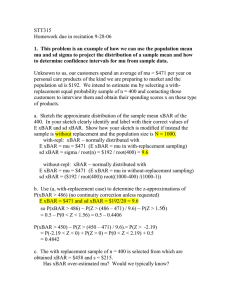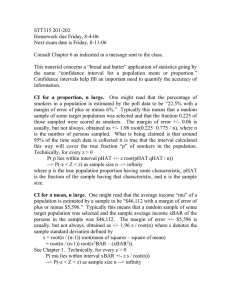STT315 Homework due in recitation 9-28-06
advertisement
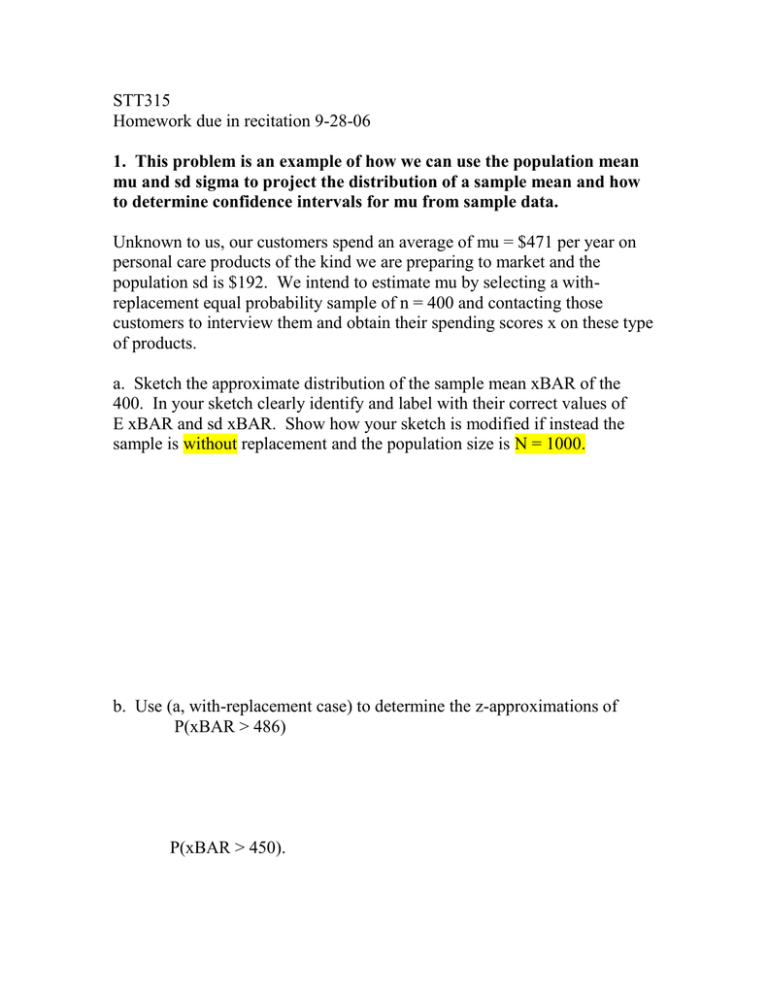
STT315 Homework due in recitation 9-28-06 1. This problem is an example of how we can use the population mean mu and sd sigma to project the distribution of a sample mean and how to determine confidence intervals for mu from sample data. Unknown to us, our customers spend an average of mu = $471 per year on personal care products of the kind we are preparing to market and the population sd is $192. We intend to estimate mu by selecting a withreplacement equal probability sample of n = 400 and contacting those customers to interview them and obtain their spending scores x on these type of products. a. Sketch the approximate distribution of the sample mean xBAR of the 400. In your sketch clearly identify and label with their correct values of E xBAR and sd xBAR. Show how your sketch is modified if instead the sample is without replacement and the population size is N = 1000. b. Use (a, with-replacement case) to determine the z-approximations of P(xBAR > 486) P(xBAR > 450). c. The with replacement sample of n = 400 is selected from which are obtained xBAR = $458 and s = $215. Has xBAR over-estimated mu? Would we typically know? Has s over-estimated sigma? Would we typically know? What is our estimate for the sd of xBAR? d. Give the usual z-based 90% confidence interval for mu. Does it cover the true mu? Would we typically know this? e. Give the usual z-based 90% confidence interval for mu if instead the sample of 400 had been selected without replacement and the population size is N = 1000. f. What is the approximate value of P(mu in [ xBAR +/- 1.96 s / root(n) ]) for large n? g. All else being equal, what happens to the width of a confidence interval if the sample size is quadrupled? h. We desire a 95% confidence interval xBARFINAL n +/- 10 and are willing to pay whatever it costs in terms of expanding our sample of 400 to some possibly larger sample size “FINAL n.” What final sample size will do the job? Consult section 6-6, but use s in place of sigma in formula (6-10) since we typically do not know sigma but must estimate it as the value of our sample sd s = $215 of the initial sample of 400. If we do continue to sample up to this “FINAL n” sample size, and if we should find that the sample mean out to this final sample size is $475, what will be our 95% confidence interval for mu? Look at the first line of (h). 2. This problem explores the use of a t-based confidence interval for the mean mu of a normal population. As in (1) we will suppose that, not known to us, the population mean mu is $471. Suppose now that the population scores are (at least roughly) normal distributed and that a sample of only n = 6 customers has produced a sample mean xBAR = $458 and sample sd s = $215. a. Use the t-table and the sample information just above to give a 90% confidence interval for mu. Does this interval cover the true population mean? b. Refer to (b). Before the sample of n = 6 is selected what is the numerical value of the probability P(mu in [ xBAR +/- 4.032 s / root(6) ])? 3. This problem is an example of how we can use the population proportion p to project the distribution of a sample proportion pHAT and how to determine confidence intervals for p from sample data. Unknown to us, 31% of our customers use a personal care product of the kind we are preparing to market. We intend to estimate this p (which is p = 0.31 but we don’t know that) by selecting a with-replacement equal probability sample of n = 400 and contacting those customers to interview them and determine whether or not they use such a product. a. Sketch the approximate distribution of the sample proportion pHAT for n = 400. In your sketch clearly identify and label with their correct values of E xBAR and sd xBAR. Show how your sketch is modified if instead the sample is without replacement and the population size is N = 1000. b. Without using any continuity corrections, use (a, with-replacement case) to determine the z-approximations of P(pHAT > .28) P(pHAT < .34). c. A with replacement sample of 400 is selected, from which are obtained 130 customers who use a product of this type. What is pHAT? Has it overestimated p? Would we typically know? Using pHAT, what is our estimate of the population sd for score x = 1 if use product of this type, x = 0 otherwise What is our estimate for the sd of pHAT? d. Give the usual z-based 95% confidence interval for p. Does it cover the true p? Would we typically know this? e. Give the usual z-based 95% confidence interval for p if instead the sample of 400 had been selected without replacement and the population size is N = 1000. f. What is the approximate value of P(mu in [ xBAR +/- 1.96 root(pHAT qHAT) / root(n) ]) for large n? g. All else being equal, what happens to the width of a confidence interval if the sample size is quadrupled? h. We desire a 95% confidence interval pHATFINAL n +/- 0.03 and are willing to pay whatever it costs in terms of expanding our sample of 400 to some possibly larger sample size “FINAL n.” What final sample size will do the job? Consult section 6-6, but use pHAT qHAT (from our initial 400) in place of pq in formula (6-11) since we typically do not know sigma but must estimate it from the initial sample of 400. If we do continue to sample up to this “FINAL n” sample size, and if we should find that the pHAT from this final sample size is 0.321, what will be our 95% confidence interval for mu? Look at the first line of (h). 4. This problem is an example of how we can estimate the population mean mu using a proportionally stratified sample and how to develop a z-based confidence interval for this estimate. See the reading assignment for this week. Suppose that 40% of our customer population lives in a large city. We decide to sample 400 customers in a stratified way by sampling 0.4 400 = 160 with repl from our customers living in a large city and the remaining 240 with repl from our customers who do not live in a large city. Our findings from this sampling are xBARcity = $453 xBARnoncity = $399 sCITY = $185 sNONCITY = $213 nCITY = 160 nNONCITY = 240 a. What is our estimate of mu1 = the mean yearly expenditures of large city dwelling customers on products of the type we will be introducing? b. What is our stratified estimate xBARSTRAT of mu = mean yearly expenditures of our entire customer base on products of the type we will be introducing? c. Give the 95% z-based CI for mu using xBARSTRAT. d. What advantage is claimed for using the above proportionally stratified sampling approach to estimate mu instead of just taking a straight withreplacement n = 400 sample of the population and using muHAT? 5. This problem is an example of how we can estimate the population proportion p using a proportionally stratified sample and how to develop a z-based confidence interval for this estimate. See the reading assignment for this week. Suppose that 40% of our customer population lives in a large city. We decide to sample 400 customers in a stratified way by sampling 0.4 400 = 160 from our customers living in a large city and the remaining 240 from our customers who do not live in a large city. Our findings from this sampling are 39 of the 160 use a product of the type we will be introducing 92 of the 240 use a product of the type we will be introducing a. What is our estimate of p1 = the proportion of large city dwelling customers who use a product of the type we will be introducing? b. What is our stratified estimate pHATSTRAT of p = proportion of our entire customer base who use a product of the type we will be introducing? c. Give the 95% z-based CI for p using pHATSTRAT. d. What advantage is claimed for using the above proportionally stratified sampling approach to estimate p instead of just taking a straight 400 sample of the population and using pHAT?
